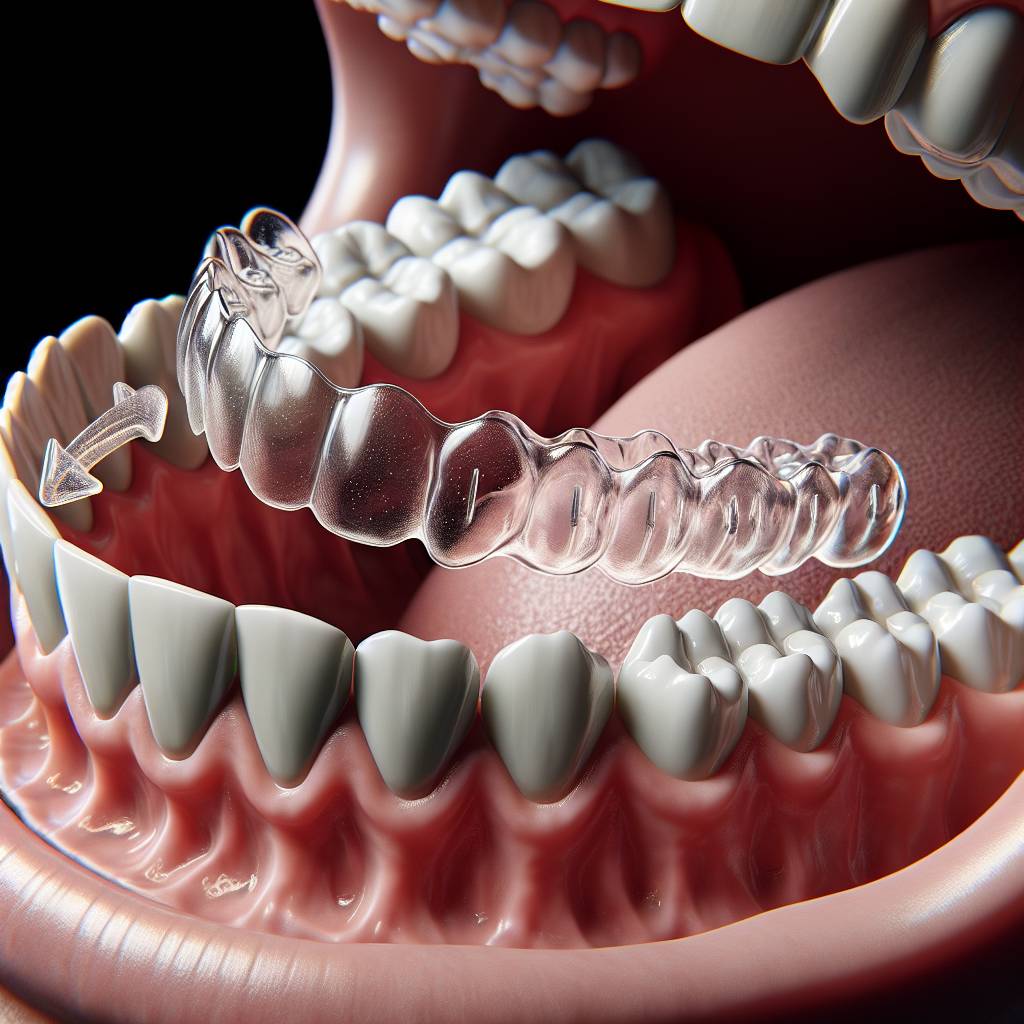Aligners are a modern alternative to traditional metal braces for improving your smile. They are made of clear, lightweight plastic and fit over your teeth like a snug mouthguard. By gradually shifting your teeth into the desired position, aligners can fix gaps, crowding, and misalignment. As well as providing a more discreet way to straighten your teeth compared to traditional braces, aligners also move your teeth faster and with less discomfort. In this article we will explain how aligners move your teeth and the advantages they offer.Aligners are clear plastic trays that are custom-made to fit over your teeth. They are an increasingly popular alternative to traditional metal braces for straightening teeth. Aligners use gentle, steady pressure to gradually move teeth into their desired positions. They are removable, allowing you to eat and brush your teeth as normal and can be taken out for special occasions like taking pictures or playing a wind instrument.
How Do Aligners Work?
Aligners are a popular choice for those looking to improve their smile without the use of traditional metal braces. They work by gradually straightening your teeth over time. The aligners are custom-made to fit your individual teeth and gently move them into place. You will need to wear the aligners for at least 22 hours each day, taking them out only to eat and brush your teeth. Every two weeks you will switch out the aligner for a new one that is slightly different in shape and helps keep up with the progress of your treatment. The entire process typically takes between 6-18 months, depending on how much straightening needs to be done.
These aligners are made of a clear plastic material, making them almost invisible when you’re wearing them. This makes them more desirable than traditional braces, as they won’t interfere with your appearance during treatment. Aligners are also removable, so you can take them out when necessary and clean them easily. They are also more comfortable than traditional braces as there is no metal in the mouth or sharp edges that can irritate gums or cheeks.
Aligners have been proven effective in improving misaligned smiles, and can help fix issues such as overcrowding or gaps between teeth. However, they may not be suitable for everyone depending on the severity of the misalignment, so it is important to consult with an orthodontist before starting any treatment plan.
Benefits of Using Aligners
Straightening your teeth with aligners has many advantages. Aligners are an excellent alternative to traditional braces as they are more discreet and comfortable. Aligners can be removed for eating, brushing and flossing, making it easier to keep your teeth clean. In addition, there are no restrictions when it comes to what you can eat as you can simply remove the aligners before eating. Aligners also require less visits to the dentist as adjustments don’t need to be made like they do with braces.
Aligners also provide a more precise fit than traditional braces. This is because each aligner is custom-made specifically for you using 3D computer imaging technology. This allows for more accurate tooth movement and better results in a shorter amount of time compared to braces. As a result, it may take approximately 6 months or less to achieve your desired results.
Another benefit of using aligners is that they put less force on the teeth than traditional braces, which makes them more comfortable for long-term wear. Plus, there are no metal brackets or wires that need to be adjusted like with traditional braces, so you won’t experience any discomfort from wires rubbing against your gums or cheeks.
Finally, aligners are less noticeable than traditional braces making them ideal for adults who don’t want the hassle of dealing with metal brackets and wires in their mouths. In addition, they can be taken out when necessary so you won’t have to worry about wearing them at social events or special occasions if you don’t want to.
Overall, using aligners has many benefits over traditional braces including being more comfortable and less visible. Plus, they provide a more precise fit and faster results compared to traditional braces which makes them an ideal choice for anyone looking for a straighter smile in a short amount of time.
Types of Aligners
Aligners are a type of orthodontic treatment used to straighten teeth. They are an increasingly popular option for those seeking to improve the appearance of their smile without the use of traditional metal braces. Aligners are removable and typically made from clear plastic, making them virtually invisible when worn. There are several types of aligners available, each with its own advantages and disadvantages.
Invisalign is one of the most popular brands of aligners on the market today. They are made from a strong, transparent plastic that is custom-fitted to your teeth for a comfortable fit that is virtually undetectable when worn. Invisalign aligners can be removed for eating and drinking so you don’t have to worry about food getting stuck in your braces. They also require fewer dental visits than traditional braces, making them more convenient for busy adults.
ClearCorrect is another popular brand of clear aligners that offer similar advantages as Invisalign but at a more affordable price point. ClearCorrect uses a series of custom-made plastic aligners that gradually move your teeth into place over time. Like Invisalign, ClearCorrect can be removed for eating and drinking and requires fewer dental visits than traditional metal braces.
Simpli 5 is an ideal option for those seeking a more cost-effective solution for correcting mild to moderate orthodontic issues. Simpli 5 consists of just five clear aligners that gradually move your teeth into the desired position over time, usually in just six months or less. This makes it an ideal solution for those who don’t have the time or money for more involved orthodontic treatments like Invisalign or ClearCorrect.
Finally, there are also retainers available which are used to maintain the results achieved with other types of orthodontic treatments such as traditional metal braces or clear aligners. A retainer typically consists of two pieces: a metal wire and an acrylic plate that fits over the teeth like an invisible mouthguard, holding them in place while allowing you to speak normally and eat comfortably without fear of shifting teeth or relapse after treatment has been completed.
No matter which type of aligner you choose, it’s important to consult with your dentist or orthodontist before beginning any type of orthodontic treatment in order to ensure optimal results and minimize any potential risks associated with these treatments.
The Process Of Moving Teeth With Aligners
Aligners are an increasingly popular alternative to traditional metal braces, and can be a great way to straighten teeth. The process of moving teeth with aligners is fairly straightforward and relatively painless. First, your dentist or orthodontist will take an impression of your teeth and create a mold. From this mold, custom aligners are created that are designed to fit your unique mouth shape.
The aligners are made from a clear plastic material that is both comfortable to wear and nearly invisible when placed over the teeth. Your dentist or orthodontist will provide you with a series of aligners that you’ll need to change out every two weeks. As you progress through the series, each set of aligners will gradually move your teeth into the desired position.
Throughout the process, it’s important to wear the aligners for at least 22 hours every day in order to ensure optimal results. You’ll also need to attend regular check-ups with your dentist or orthodontist so they can monitor your progress and make any necessary adjustments.
Once the treatment is complete, you may be required to wear a retainer for several months in order to help maintain the new alignment of your teeth. With proper care and maintenance, you can enjoy a beautiful smile for many years to come!

What To Expect During Treatment
When undergoing treatment for a medical condition, it is important to understand what you can expect during the process. Many treatments involve a variety of different steps and procedures, so it is essential to be prepared for all of them. Depending on the type of treatment you are receiving, here are some of the things you might expect:
Medical Appointments: Most treatments require regular visits with your healthcare provider. This is to ensure that your condition is being monitored and that any changes in your health or symptoms are noted. At these appointments, your healthcare provider may examine you, discuss any changes in your condition or symptoms, order tests or scans, adjust medications or dosages, and more.
Lifestyle Changes: Depending on the nature of your medical condition, you may be advised to make lifestyle changes in order to aid in the recovery process. This could include quitting smoking, changing eating habits, eliminating certain foods from the diet, increasing physical activity levels, reducing stress levels, and more.
Medications: With many medical conditions come medications that need to be taken regularly. These medications can help reduce pain levels and symptoms associated with the condition while also helping to prevent future flare-ups or complications from occurring. It is important to take these medications as prescribed in order to achieve maximum benefit from them.
Physical Therapy: Physical therapy plays an important role in many treatment plans as it helps strengthen weakened or injured muscles while also improving flexibility and range of motion. Physical therapists may provide exercises that can be done at home while also providing hands-on care during appointments.
Surgery: In some cases surgery may be necessary in order to treat a medical condition properly. Surgery carries risks but can often provide relief from difficult symptoms if other treatments have failed or been unsuccessful. The type of surgery performed will depend on the nature of the condition being treated and what goals are trying to be achieved with it.
No matter what type of treatment plan you are following for a medical condition it is important that you understand what you can expect during each step of the process so that you can prepare yourself accordingly and make sure that everything goes as smoothly as possible.
Aftercare and Maintenance Of Aligners
Good aftercare and maintenance of aligners is essential for the successful movement of your teeth. Proper care of aligners should be taken every day to ensure that your treatment progresses as planned. Here are some tips you should follow to maintain your aligners:
• Always brush and floss your teeth before putting the aligners back in. Food particles can get stuck in the aligners, so it’s important to remove them before inserting them again.
• Rinse your aligners with lukewarm water after every meal or snack. This will help remove food particles and bacteria from the surface of the aligner.
• Soak your aligners overnight in a cleaning solution specifically designed for clear plastic aligners. This will help keep them clean and free of bacteria.
• Do not expose your aligners to heat or direct sunlight. The heat can distort their shape, making them less effective.
• Handle your aligners with care while removing and inserting them into your mouth. Rough handling can cause damage to the plastic, resulting in cracks or breaks.
Following these simple tips will ensure that you get the most out of your orthodontic treatment with clear plastic aligners. Taking proper care of your aligner will make sure that you achieve a beautiful smile in no time!
Risks and Disadvantages Of Using Aligners
Using aligners to straighten teeth has become increasingly popular, but there are some risks and disadvantages associated with this type of orthodontic treatment. The most common concern is the potential for the aligners to cause gum irritation or even infection. In some cases, the aligner can cause discomfort due to the pressure it exerts on the teeth. It is important for patients to follow their orthodontist’s instructions for using and caring for their aligners in order to minimize any potential risks or complications.
Another potential risk of using aligners is that they may not be suitable for all types of teeth alignment issues. For example, if a patient has severely crooked teeth, they may require more invasive orthodontic treatment such as braces. Additionally, some patients may find that the aligners do not fit properly due to inadequate dental impressions taken at the start of treatment.
Additionally, unlike traditional braces that are fixed in place, aligners must be removed and replaced every two weeks in order to achieve desired results. This means that patients must be diligent about wearing their aligners as prescribed by their orthodontist in order for treatment to be successful. If an alignment issue persists because a patient did not wear their aligner as directed, additional treatments may be required in order to correct it.
Finally, while many people believe that using aligners is a cheaper alternative to braces, this is not always the case. The cost of an aligner system can vary greatly depending on the complexity of the individual’s alignment issue and can even exceed that of traditional braces in some cases. Therefore, it is important for patients to research all available treatment options before deciding which one is right for them.

Conclusion
Aligners are a great way to move teeth quickly and comfortably. They are an effective alternative to traditional braces, and they can often be used for more complex cases than traditional braces. The aligners are made from a comfortable plastic material that can be worn day and night, making them ideal for those with busy lifestyles. Invisalign aligners are virtually invisible, so they won’t disrupt your appearance in any way.
Aligners have been proven to be as effective as traditional braces in straightening teeth, and they can often do it faster than traditional braces would. Aligners also require fewer visits to the dentist when compared with traditional braces, which is always a plus.
Overall, aligners provide a great option for those seeking to straighten their teeth without the hassle of metal brackets or wires. They offer comfort and convenience, while being just as effective as their more traditional counterparts.
So if you’re looking for an easy and effective way to move your teeth into the desired position, then aligners may be just what you need!

